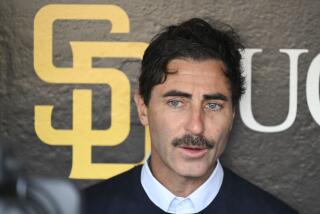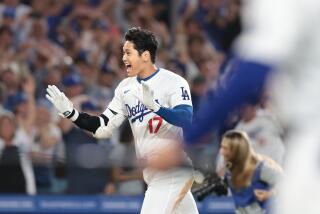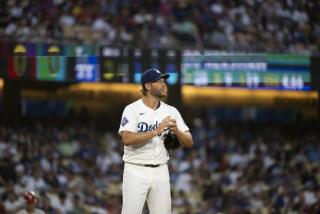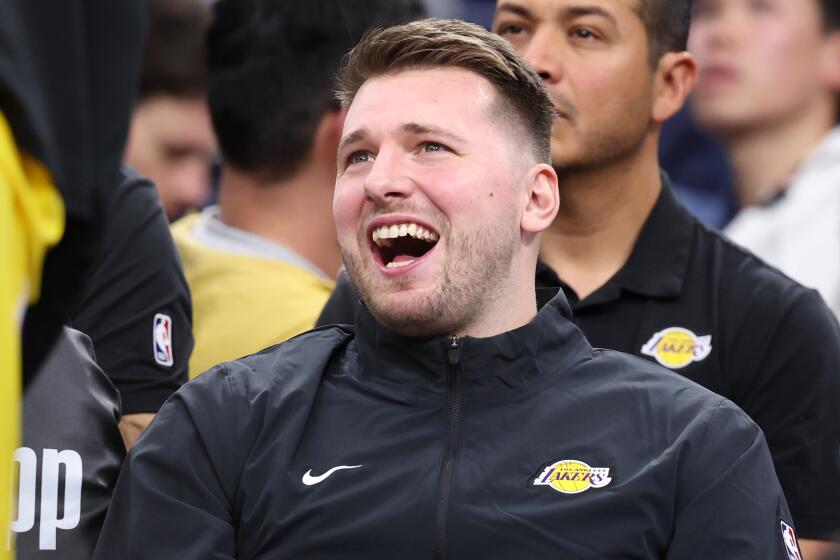Pressure Off, Power On for Padres’ Sheffield
- Share via
SAN DIEGO — You see Gary Sheffield hit a baseball and you wonder if he’s using the same ball everyone else is.
The way the ball comes off Sheffield’s bat, you want to check it for dimples. You wonder who slipped the Titleist or Top Flite to the pitcher and why in the world he went ahead and threw it.
Break it open and you’d expect lava to flow out of it.
He may be built more like a parking garage, at 5-feet-11 and 190 pounds, but they ought to call him Two-Iron. He hits balls that go through the infield six feet off the ground and end up breaking seats in left field. They look like jets taking off from aircraft carriers.
Let him hit one of those scorchers that stays in the park, and the umpire usually has to throw the ball away. It comes back looking like an egg, unless he really got all of it. Then it looks like an omelet.
If I’m playing third base when Sheffield’s at bat, I call time out and put on a chest protector and mask. Either that or I make sure my worker’s comp is paid up.
Fred McGriff and John Daly might hit a ball farther than Sheffield, but no one hits it as hard.
And to think, all he ever wanted to be was a pitcher . . . like his uncle, Doc Gooden.
The only reason anyone bothered batting back in those boyhood days in Tampa was because someone had to be the straight man or, maybe more accurately, the fall guy.
“Pitching was all anyone really cared about,” Sheffield said. “It was something we always did. We patterned our games around pitching. I always threw hard. I had the type of fastball that ran in on hitters and I knew I could be a great pitcher if I came up with a breaking ball.”
Regardless of whether he ever came up with that breaking ball, he had a high school coach who had other ideas. He couched his notion carefully, cognizant as he was of Sheffield’s aspirations to throw rather than hit a baseball.
“He told me if I put on weight I could make it as an everyday player if I didn’t make it as a pitcher,” Sheffield recalled. “I got bigger my senior year. After that, I started hitting balls over fences.”
There didn’t seem any doubt the kid would “make it.” He made minor league all-star teams in 1986, 1987 and 1988 and came to the major leagues with the Milwaukee Brewers at the age of 19. No one back there expected him to win a triple crown, at least not until he was in his 20s.
Sheffield, all of 23 now, sat in front of his Padre locker late Thursday afternoon. I had not intended to ask him about those lost seasons in Milwaukee. Instead, I was curious about how a guy enters a season with 21 career home runs and suddenly has 20 on the afternoon of Aug. 6 . . . and two more to come shortly thereafter.
To get forward to San Diego, it seems, you have to go back to Milwaukee.
“I came into Milwaukee,” he said, “and they expected me to be a savior. The organization had failed for so many years they were looking for someone to turn it around. The expectations ran too high, too early. The goals other people set for me were unrealistic.”
Remember, he had come up at the age of 19.
Sheffield heard that he was supposed to do this and do that and then do some more. He thought that maybe he could do part of it, like maybe sacrifice power and try to bat .300. A kid that age couldn’t do it all.
Fred McGriff, playing in Toronto at the time, was paying attention. After all, the kid was from his hometown.
“Here he was hitting third with a lot of pressure on him,” McGriff said, “and he wanted to show people he could play. I noticed he was trying to make contact and go the other way and try to get his hits.”
What happened was that Sheffield did not make anyone happy. And he was among those unhappy.
All of that changed on March 27 when the Padres obtained him from the Brewers. It helped that they surrendered nondescript players such as pitcher Ricky Bones and infielder Jose Valentin. He would not come to San Diego haunted by expectations, that ghost (and burden) having been left behind.
“I was just one of the ballplayers,” he said. “That’s the way I’ve always wanted to be.”
What he has done, consequently, is prove that he is not just another ballplayer. Far from it. He is among the National League leaders in batting average, runs batted in and home runs. He is an All-Star player.
Is he fearful, perhaps, that the ugly specter of expectations might recycle itself?
“I have talent,” he said, “and I expect big things, but the thing is that I have three years experience now in the big league. It’s a matter of believing, and that helps a lot. I’m just going out and having fun.”
Someday, some pitcher is going to stand out there on the mound and look in at Gary Sheffield with a bat in his hand and remember what Sheffield really wanted to be.
“Hey,” he’ll scream, “you really want to be a pitcher? Come out here and throw this damned ball to yourself. I have a wife, three kids and an agent to support. You can have this job. I’d rather milk cobras.”
More to Read
Go beyond the scoreboard
Get the latest on L.A.'s teams in the daily Sports Report newsletter.
You may occasionally receive promotional content from the Los Angeles Times.










